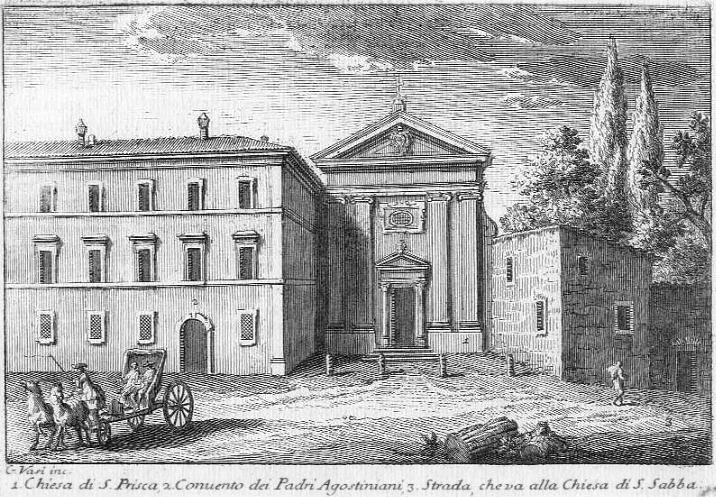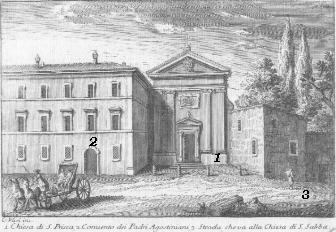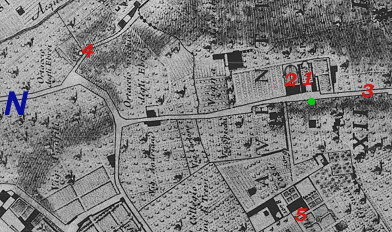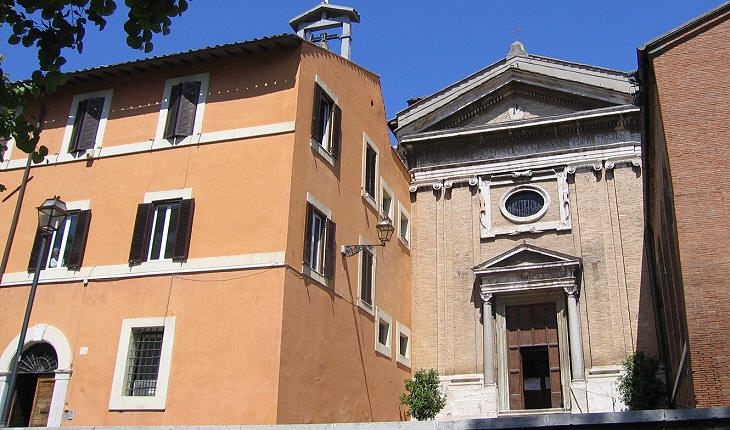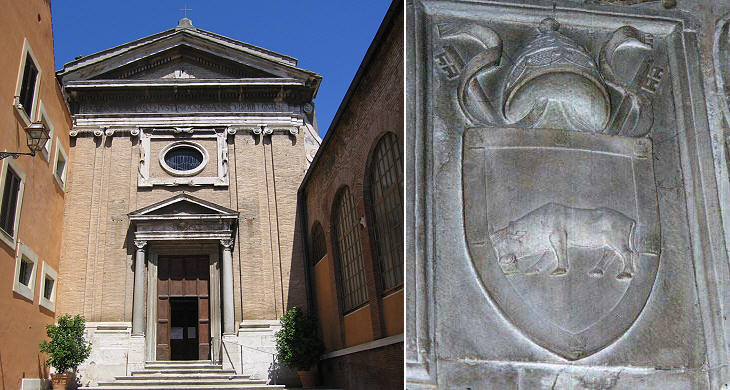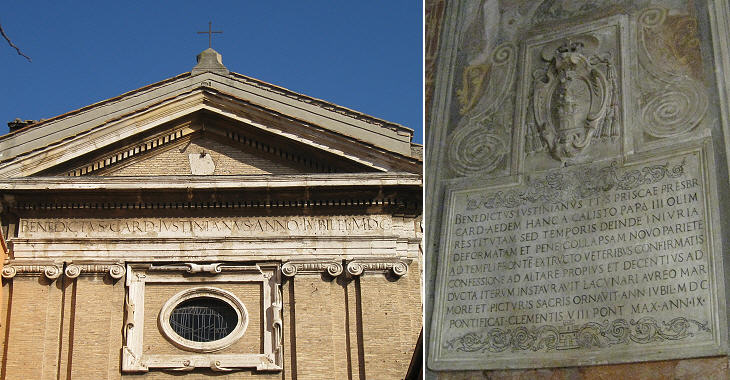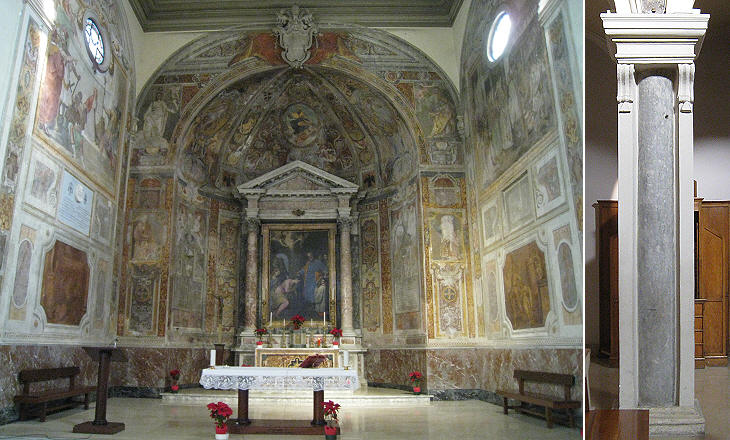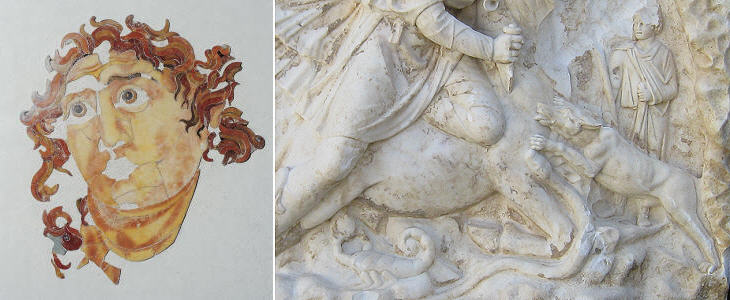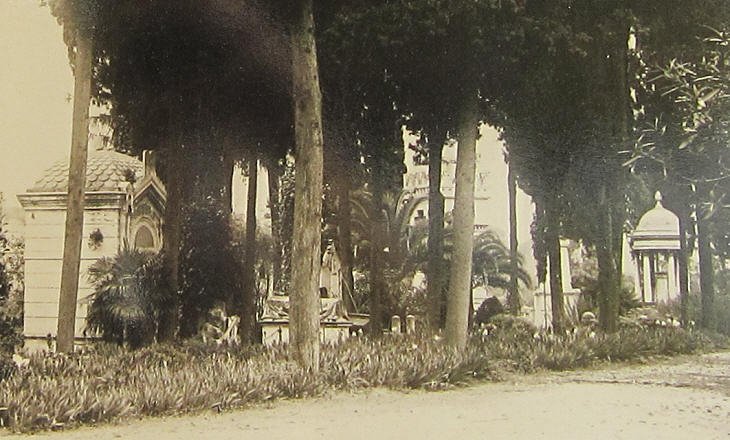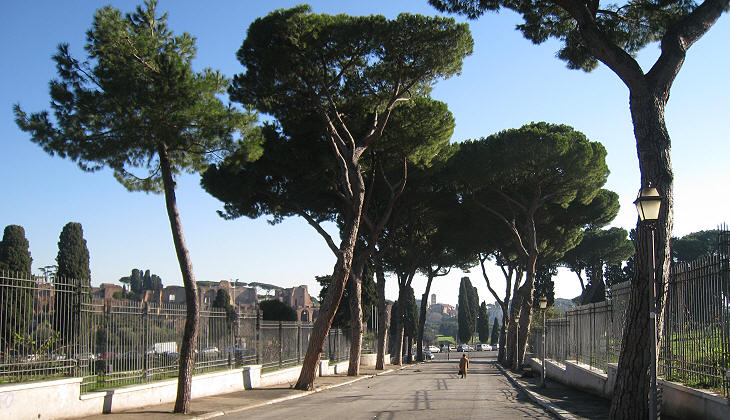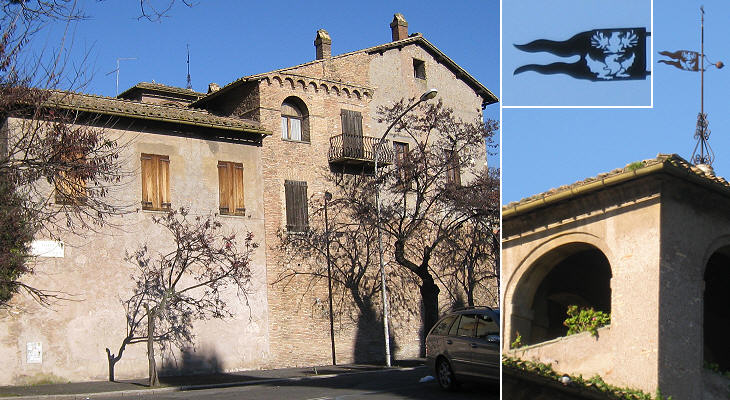  What's New! Detailed Sitemap All images © by Roberto Piperno, owner of the domain. Write to romapip@quipo.it. Text edited by Rosamie Moore. Page revised in February 2010. | S. Prisca (Book 3) (Map C3) (Day 5) (View C10) (Rione Ripa)
In this page:
In the XVIIIth century the Aventine hill had a rather rural appearance and this is evident in the etching by Giuseppe Vasi; Aqua Appia and Aqua Marcia the two ancient Roman aqueducts which provided an ample supply of water to the hill were not rebuilt by the popes and so the Aventine was very scarcely populated; apart from medieval monasteries (S. Saba, S. Sabina and S. Alessio in addition to S. Prisca) there were only farms and Ortaccio degli Ebrei, the Jewish cemetery. The view is taken from the green dot in the small 1748 map here below. In the description below the plate Vasi made reference to: 1) S. Prisca; 2) Augustinian monastery adjoining the church; 3) Street leading to S. Saba. The small map shows also 4) Ortaccio degli Ebrei and 5) Vigna Maccarani Torlonia.
Today
The farms have been replaced by a residential development, but the almost total absence of shops and the limited impact of traffic keep the Aventine hill away from the chaos of other parts of today's Rome. S. Prisca has gained a modern bell tower and it has lost the coat of arms of Pope Clement VIII, but otherwise the view has not changed significantly. S. Prisca
According to tradition Prisca was a young Christian girl who was baptized by St. Peter; she was sentenced to death in the circus by Emperor Claudius, but the lions refused to touch her and she was eventually beheaded. A small oratory, which probably was an early church dedicated to Prisca, was unearthed in the XVIIIth century in the proximity of the current church which was built in the Vth century. The medieval church was longer than it is today because in the XVth century a fire destroyed the first three bays. A lengthy inscription and a coat of arms celebrate a restoration by Pope Calixtus III, but the church remained shortened, an indication of the reduced importance of the area.
Cardinal Benedetto Giustiniani belonged to a family of Genoese origin, but he was born in Scio (today Chios), an island of the Aegean Sea which was ruled by his family. When the Ottomans occupied the island the Giustiniani came to live in Rome and owing to their wealth they soon became one of the most important families of the city. Cardinal Benedetto Giustiniani commissioned Carlo Lambardi a new façade for S. Prisca and he restored the whole building. You may wish to see the church as it appeared in a 1588 Guide to Rome.
In the XVIIIth century Pope Clement XII promoted a new restoration of the church; notwithstanding the many changes that occurred throughout the centuries S. Prisca retains its original design: it has the shape of an ancient Roman basilica i.e. a large rectangular hall with an apse at its end and with two rows of columns dividing it into three naves.
In 1933 excavations were made to strengthen the foundations of the church, but they were expanded when they unearthed the structure of a large Roman house of the end of the Ist century; it included a mithraeum, a small underground hall for the cult of Mithras, a Persian god. Archaeologists have found evidence indicating that it was built before 202 AD, an indication of when this oriental belief penetrated the upper classes of Roman society (at that time the Aventine was the residence of many wealthy families). In many mithraea archaeologists have found a relief on a small altar at the end of the hall; almost all of them portray Mithras in the act of slaying a bull; the two are surrounded by animals and human beings having a symbolic meaning; it is generally thought that the animals represent constellations: the bull indicates the constellation of Taurus, the dog Canis Minor, the snake Hydra and the scorpion Scorpio. These constellations together with that of Corvus (raven, shown in another section of this relief) were all aligned on the celestial equator during the spring equinox in that age. The Greco-Roman world, after having located the gods in deep forests (see a page on the shrine of Dodoni) and later on having believed that the gods inhabited the highest mountains (see a page on the Oracle of Delphi), eventually reached the conclusion that the gods lived above the clouds (a relief of Arco di Tito portrays an eagle carrying the divinized emperor to Heaven); during the same period the Greco-Roman world moved from the cult of a host of deities to that of Jupiter and his merry family and eventually to that of a pre-eminent god (Mithras or Sol Invictus). Ortaccio degli Ebrei
The Jews of Rome had their cemetery near Porta Portese Antica; when Pope Urban VIII built the new walls of Trastevere the cemetery was expropriated because it stood on the path of the new fortifications; in 1645 the Jews were allowed to buy a piece of land on the northern slope of the Aventine, not far from the Ghetto, where in 1556 they had been forced to live.
In 1895 the Jewish Community was assigned a space inside Cimitero del Verano and eventually in 1934 the remains of those buried in Ortaccio degli Ebrei were relocated there. The whole area around Circus Maximus was redesigned and the old cemetery became a public rose-garden (where you can have a stroll by clicking here). Old Farms
Apart from the monasteries and the churches, very few other buildings of the Aventine are old; Vigna Maccarani Torlonia has not been replaced by a modern house, because its garden and the building itself retain some ruins of the baths built by Emperor Decius in the IIIrd century AD. Excerpts from Giuseppe Vasi 1761 Itinerary related to this page:
Next plate in Book 3: SS. Nereo e Achilleo Next step in Day 5 itinerary: S. Sabina Next step in your tour of Rione Ripa: SS. Nereo ed Achilleo |
